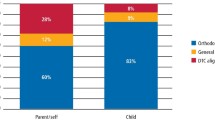Key Points
-
There is a need to focus attention not only on prepared teeth but also the remaining teeth in the same arch when making impressions for indirect restorations.
-
When using dual phase impressions, clinicians need to be careful when seating the loaded impression tray so as to avoid subsequent inaccuracies in dental casts.
-
On the whole clinicians are better at making impressions for study and opposing casts than working crown and bridge impressions.
Abstract
Objective To assess the quality of dental casts used in crown and bridge construction.
Design Observational cross-sectional study of dental casts.
Setting Commercial dental laboratories and a university dental hospital laboratory in the UK.
Materials and methods A sample (n = 150) of working and opposing casts used for crown and bridgework prescribed by general dental practices and a dental hospital were sampled from two commercial dental laboratories and an 'on-site' university dental hospital laboratory respectively. A simple '3 point' assessment scale of quality (good, fair and poor) was used to categorise the casts depending on the clarity of reproduction of soft and hard tissues.
Results The quality of opposing casts used for articulation purposes was significantly better (P<0.001) than that of the working casts. In addition it was found that for working casts the quality in the preparation area(s) was significantly better (p<0.001) than that in areas remote from preparation(s) in the same arch. In general, the quality of casts in the incisal or occlusal surfaces was better than the buccal and lingual surfaces.
Conclusions This study has demonstrated that variation exists in the quality of casts used in crown and bridgework, specifically those used in the construction of indirect restorations and also those used for articulation purposes. This study highlights the need for clinicians to exercise continued vigilance with crown and bridge impressions, and casts, particularly in areas away from the prepared teeth.
Similar content being viewed by others
Log in or create a free account to read this content
Gain free access to this article, as well as selected content from this journal and more on nature.com
or
References
Winstanley RB . Crown and bridge impressions- a comparison between the UK and a number of other countries. Eur J Prosthodont Restor Dent 1999; 7: 61–64.
Shillingburg HT, Hobo S, Whitsett LD, Jacobi R, Brackett SE . Fundamentals of fixed prosthodontics. 3rd ed. P 309. Chicago, IL: Quintessence Publishing Co, 1997.
British Society for Restorative Dentistry. Guidelines for crown and bridge. Eur J Prosthodont Restor Dent 1999; 7: 3–9.
Carrotte PV, Winstanley RB, Green JR . A study of the quality of impressions for anterior crowns received at a commercial laboratory. Br Dent J 1993; 174: 235–240.
Winstanley RB, Carrotte PV, Johnson A . The quality of impressions for crowns and bridges received at commercial dental laboratories. Br Dent J 1997; 183: 209–213.
Randall RC, Wilson MA, Setcos JC, Wilson NHF . Impression materials and techniques for crown and bridgework: a survey of undergraduate teaching in the UK. Eur J Prosthodont Restor Dent 1998; 6: 75–78.
Davies SJ, Gray RM, Smith PW . Good occlusal practice in simple restorative dentistry. Br Dent J 2001; 191: 365–368.
Author information
Authors and Affiliations
Corresponding author
Additional information
Refereed paper
Rights and permissions
About this article
Cite this article
Alhouri, N., McCord, J. & Smith, P. The quality of dental casts used in crown and bridgework. Br Dent J 197, 261–264 (2004). https://doi.org/10.1038/sj.bdj.4811621
Received:
Accepted:
Published:
Issue date:
DOI: https://doi.org/10.1038/sj.bdj.4811621
This article is cited by
-
Comparison of digital and conventional impression techniques: evaluation of patients’ perception, treatment comfort, effectiveness and clinical outcomes
BMC Oral Health (2014)
-
Study of casts for crown and bridgework
British Dental Journal (2004)



